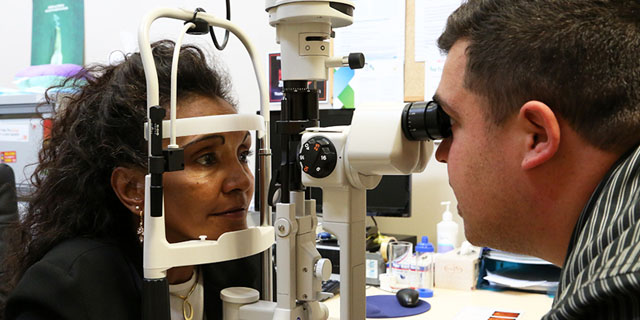Grampians lead way in Indigenous eye health
Indigenous Eye Health at the University of Melbourne have led a community initiative to close the gap in vision loss.

This article originally appeared in Voice, Volume 11 Number 8. View the original here.
Community-led projects are helping narrow the gap, says Lisa Mamone.
Vision loss accounts for 11 per cent of the Indigenous health gap, but community-led projects such as those in Victoria's Grampians region show that narrowing the gap is achievable.
In one year, 75 per cent of Indigenous patients with diabetes had their recommended annual retinal screening in the Grampians through the existing service systems, compared with a national baseline of only 20 per cent.
Successes in the Grampians illustrate the importance of strong community-led care and state government leadership in the region. Employing a locally-based project officer was an important factor, and the project was supported by the tools and recommendations developed by the Indigenous Eye Health (IEH) group at the University of Melbourne, led by Laureate Professor Hugh R Taylor AC.
Key partners and community stakeholders came together to look at the region and identified the gaps and barriers to care. Eye services have increased, pathways to care are defined, and funding for equipment and a directory of services and providers were introduced to health care and community workers.
Mitchell Anjou, senior research fellow at IEH, described how progress in the Grampians is the result of a series of elements. The project has engaged community leaders, local and state government and service providers to assess the current level of service for the region, and determine the unmet eye care needs of the Indigenous community.
"There is a multi-faceted story to tell," says Anjou. "Layered advocacy and a shared common goal are necessary parts of the success. You can't achieve change locally without endorsement and collaboration with community, and this needs to be supported at the state level and, then of course nationally."
Several years ago Premier Daniel Andrews, then Victorian Health Minister, funded important initiatives including the subsidised spectacle scheme, a statewide co-ordinator for eye health based in the Victorian Aboriginal Community Controlled Health Organisation, and an Aboriginal patient pathway support worker at the Royal Victorian Eye and Ear Hospital. These programs continue to have bipartisan support, with eye health included in the state Koolin Balit Aboriginal health plan.
"Eye care is important as most vision loss can be corrected overnight,'' says Professor Taylor, "for example the impact of cataract surgery is fast and life-changing. To go from being blind to seeing the next day is incredible. Rates of cataract surgery are seven times less for Indigenous Australians and this is something we need to turn around. The annual eye examination for Indigenous people with diabetes is essential to prevent them from losing their sight."
Diabetic retinopathy is one of four conditions along with refractive error (the need for glasses), cataract and trachoma that together cause 94 per cent of the vision loss for Indigenous Australians. Up to 98 per cent of the blindness from diabetes is preventable with early detection and timely treatment.
The Indigenous Eye Health group at the University developed the Roadmap to Close the Gap for Vision, an evidence-based plan that is transforming Indigenous eye care across Australia. The Roadmap addresses each of the four conditions and provides a template for integrating primary care with specialist services.
Real change to close the gap in eye health is possible. Effective and efficient pathways mean waiting times can be shortened and cost-effective services implemented and these results support improved engagement from both patients and health workers.
The Grampians region has set itself up as an example of a successful model in community engagement and patient uptake of eye care services.